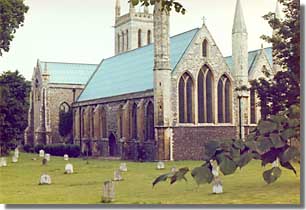
St. Nicholas' reflects the essence of medieval Yarmouth as a town reliant on the sea and its harvest. Dedicated to the patron saint of sailors and others who earn their livelihood from the sea, it was built by the Bishop of Norwich in the early twelfth century to supersede an earlier church believed to have been created to serve the local and visiting (Cinque Ports) fishermen.
As the sole parish church serving Yarmouth, St. Nicholas' was over time expanded into a relatively large building capable of holding a sizeable congregation. It was the beneficiary of many bequests from townspeople, who also contributed to extensions of the building, while social gilds also contributed to its improvement (notably the creation of chapels with which they then became associated). The creation of a "Bachelor's aisle" in the 1330s was halted by the Black Death. As was the case with many urban parish churches, its fabric was renovated and improved in the fifteenth century. Destroyed by bombing in the Second World War, the church was rebuilt on its medieval plan and re-consecrated in 1960.
The parish system developed at about the same time that towns were proliferating, in the Anglo-Saxon period. In the beginning, a town was often served by a single mother church, typically founded by the lord of the land, unless it emerged from the amalgamation of several settlements or estates of different landlords, each served by its own church (e.g. Norwich). As urban populations grew and boundaries expanded, new churches and parishes appeared, some quite small; Yarmouth and Bishop's Lynn represent exceptions to this process, perhaps because of the pre-eminent role of the Bishop in each and because of limited scope for geographical expansion. In the twelfth century the Church asserted control over many of the privately-owned parish churches.
These churches provided a key element of medieval urban society and culture. Spiritual comfort and security in life and in death is one of the most evident contributions. But among the roles that prominent churches and their churchyards played in medieval times was that of meeting-place for the community at large, or (inside) for smaller assemblies, to debate borough business; as well as sanctuary for criminals, who might hope for protection there from the mob or the agents of authority, for long enough for them to abjure the realm (i.e. admit to their crimes and take an oath to leave the country). Another role was as a solemn location for the conduct of private business, such as the making of a commercial contract (for which a deposit sometimes known as "God's penny" was a further guarantee of good faith), the payment of debt instalments, or the taking of oaths.
Not all of the multiple urban parish churches had, or could maintain over time, large enough congregations to earn the income (e.g. from tithes) to survive. However, in the Late Middle Ages, the foundation by townspeople of socio-religious gilds (and chapels, within parish churches, to serve them), the endowment of chantries to pray for the souls of the deceased, and the combination of pride and bad conscience that encouraged prospering merchants to channel some of their profits into renovation projects, all helped keep many churches vigorous institutions in the life of the town.
For further information on St. Nicholas' see
the church's Web site
and
Palmer's Perlustration of Great Yarmouth.
